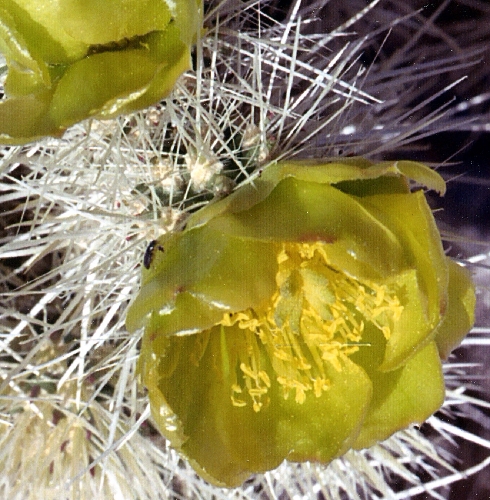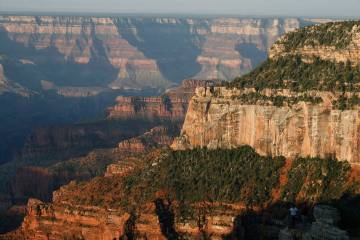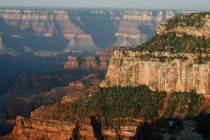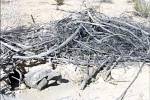Rhodes’ Red Rock plan encounters new sticking point
Developer Jim Rhodes might hit another thorny snag in his quest to build a subdivision next to Red Rock Canyon: a state-protected cactus.
The Blue Diamond cholla is a stubby, big-needled cactus that grows on Rhodes' hillside land. It is one of 24 plants that Nevada lists as "critically endangered."
Although protected plants have never been known to kill a project in Nevada, they have compelled developers to change their plans to accommodate them.
It is yet another challenge that Rhodes faces in his revived effort to develop houses, businesses and perhaps a school on 2,400 acres atop a mesa just east of Red Rock, a popular hiking, climbing, biking and picnicking area.
Rhodes also must contend with growing opposition to a project that many assumed died years ago.
Clark County commissioners are expected to vote Wednesday on a deal that would let him apply for higher-density housing than the zoning now allows in the Red Rock "overlay district."
Many who oppose the project want no compromise, despite the Nevada Supreme Court ruling last year that state-imposed restrictions on his land singled Rhodes out unfairly.
A large, vocal group of naysayers is expected to show up Wednesday, including from Blue Diamond, a small enclave near Rhodes' site.
Evan Blythin, a Blue Diamond resident, said the endangered cactus could be among the casualties of a hefty development in the area. He is adding it to his list of gripes against Rhodes' plans.
"There actually are a number of fairly fragile plants on Blue Diamond Hill, and the cholla is the most endangered, at least as I understand it," Blythin said. "I can't imagine what 5,000 homes on that hill would do to the flora and fauna of the canyon, to its air quality, to its sense of remoteness."
No one could say exactly how nettlesome the cactus could be for Rhodes because he has yet to determine where homes, expected to be in the million-dollar range, would be built, and how many plants would be affected.
State law forbids disturbing a protected plant without first obtaining a permit from the Nevada Division of Forestry.
No fee is required, and the permit is granted after developers show they have taken the proper steps to avoid harming the plants, said Matthew Koepnick, a resource management officer for the agency.
Those measures might include transplanting a species or not building on spots where the plants are particularly fragile, Koepnick said.
Every permit is different because the circumstances vary, he said, adding that some endangered plants are sturdy enough to be removed from a site and some are not.
Koepnick noted that this will be the first time his agency has handled a permit for Blue Diamond cholla.
The more intense the development, the more involved the permitting will be because of the increased chance of running into the plants, Koepnick said.
In an e-mail, Ron Krater, Rhodes' site planner, said an assessment done years ago on the cactus found that it grew on land not planned for development. However, much has changed since then, so a detailed biological study will be conducted on the plant's current habitat, he said.
"We consider this a very important natural resource and it should be dealt with appropriately," Krater said.
A protected plant is bound to affect a project, and a developer should take it seriously, Koepnick said. "It can stall and delay and potentially it could stop it."
However, he couldn't recall a project that was derailed because of an endangered plant.
Rhodes will have to hire a consultant to inventory the plants, then determine if they can be moved without hurting them, Koepnick said.
These cacti should be left alone or transplanted someplace on the mesa where the species is thriving, said Jim Morefield, a botanist with the Nevada Natural Heritage Program.
"You should go the shortest distance possible. Its habitat seems to be fairly specific. It likes the limestone, rocky hillside. You'd have to duplicate these conditions for long-term survival."
Morefield said he wouldn't recommend transplanting the cholla at a different site.
Part of what makes a plant endangered is the rare soil conditions that enable it to flourish, he said. This type of cholla is a unique and limited adornment to the desert landscape, though visually it's not as distinct as some other cacti, he said.
Still, the cactus should be preserved because if its unique genetic material is lost, there's no replacing it or the research value it might offer, Morefield said. "The first part to intelligent tinkering is keeping all the parts."
Blue Diamond cholla got its name because it is indigenous to that area near Red Rock, and for a long time didn't appear to grow anywhere else.
It has since been discovered in a half-dozen spots in the northern half of the county as well as northwest Arizona, Morefield said.
In 2005, the U.S. Fish and Wildlife Service tallied 56,000 of the plants in those regions, he said, noting that the population probably hasn't changed much in five years.
And for those who want a peek at the cactus?
"The most accessible area is Blue Diamond Hill," Morefield said.
Contact reporter Scott Wyland at swyland
@reviewjournal.com or 702-455-4519.




























